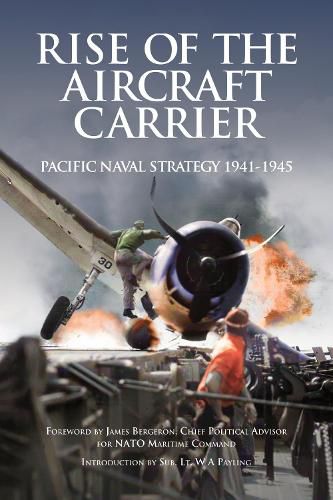Readings Newsletter
Become a Readings Member to make your shopping experience even easier.
Sign in or sign up for free!
You’re not far away from qualifying for FREE standard shipping within Australia
You’ve qualified for FREE standard shipping within Australia
The cart is loading…






On 7th December 1941, naval aircraft from six Japanese aircraft carriers destroyed the US battlefleet at Pearl Harbor, forcing the US Navy to rely on its own aircraft carriers to counter Japanese advances across the Pacific. Very fortunately, no US carriers were in port during the attack and the USN rapidly evolved a revised naval war strategy based on air strikes from aircraft carriers, the fleet's new capital ship, placed at the centre of self-sufficient task groups. Unmatched US industrial capacity enabled the design and construction of large numbers of highly capable carriers, their escorts and new naval aircraft. Despite early losses, the USN swiftly outstripped the IJN in numbers and capability, leaving the Japanese to rely on converting aircraft carriers from all manner of other vessels. Published to mark the 80th anniversary of the outbreak of WWII in the Pacific theatre, this latest volume in the Britannia Naval Histories of WWII includes two original WWII official Royal Navy documents, previously classified, that give a contemporary account of the US Navy's Pacific War strategy. These are supported by a foreword written by a current NATO Maritime Command chief political advisor, and two modern introductory papers, with a large photographic section that vividly brings to life the ships, aircraft and battles of the Pacific naval war 1941-1945.
Britannia Naval Histories of World War II - an important source in understanding the critical naval actions of the period.
$9.00 standard shipping within Australia
FREE standard shipping within Australia for orders over $100.00
Express & International shipping calculated at checkout
On 7th December 1941, naval aircraft from six Japanese aircraft carriers destroyed the US battlefleet at Pearl Harbor, forcing the US Navy to rely on its own aircraft carriers to counter Japanese advances across the Pacific. Very fortunately, no US carriers were in port during the attack and the USN rapidly evolved a revised naval war strategy based on air strikes from aircraft carriers, the fleet's new capital ship, placed at the centre of self-sufficient task groups. Unmatched US industrial capacity enabled the design and construction of large numbers of highly capable carriers, their escorts and new naval aircraft. Despite early losses, the USN swiftly outstripped the IJN in numbers and capability, leaving the Japanese to rely on converting aircraft carriers from all manner of other vessels. Published to mark the 80th anniversary of the outbreak of WWII in the Pacific theatre, this latest volume in the Britannia Naval Histories of WWII includes two original WWII official Royal Navy documents, previously classified, that give a contemporary account of the US Navy's Pacific War strategy. These are supported by a foreword written by a current NATO Maritime Command chief political advisor, and two modern introductory papers, with a large photographic section that vividly brings to life the ships, aircraft and battles of the Pacific naval war 1941-1945.
Britannia Naval Histories of World War II - an important source in understanding the critical naval actions of the period.